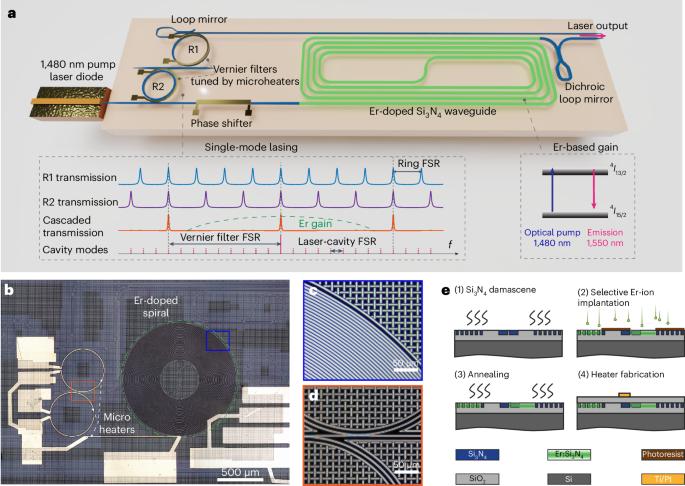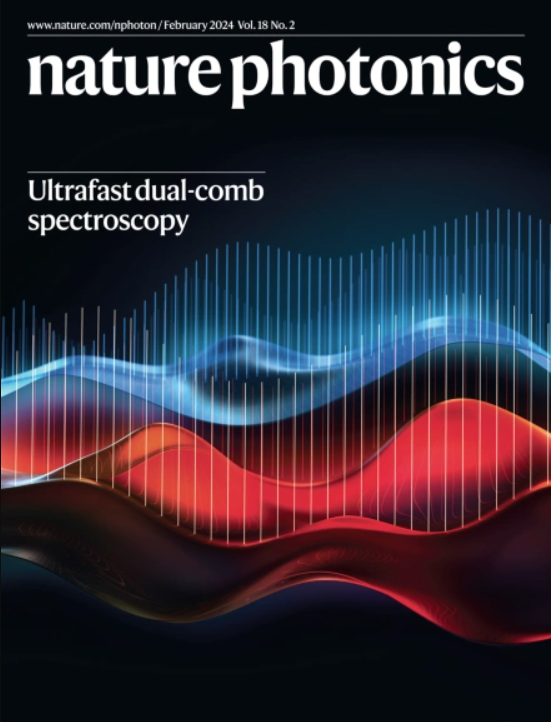完全混合集成的铒基激光器
IF 32.9
1区 物理与天体物理
Q1 OPTICS
引用次数: 0
摘要
掺铒光纤激光器具有光纤传感、陀螺仪、激光雷达和光学频率计量所需的高相干性和低噪声。在光子集成电路中加入掺铒增益,可为低噪声光纤激光器小型化到芯片级提供基础,并实现大批量应用。虽然基于硅光子技术和 III-V 增益介质的集成激光器已取得重大进展,但实现低噪声铒基集成激光器仍然遥不可及。基于光子集成电路的高功率掺铒放大器的最新进展,使新型稀土离子激光器成为可能。在这里,我们展示了一种完全集成的铒激光器,它的本征线宽为 50 Hz,输出功率高达 17 mW,强度噪声低,并集成了 III-V 泵浦激光器,性能接近光纤激光器和最先进的半导体扩展腔激光器。该激光器电路基于铒离子植入式超低损耗氮化硅光子集成电路,腔内有一个基于微孔的 Vernier 滤波器,可在光学 C 和 L 波段内实现 40 nm 波长调谐,并达到 70 dB 的边模抑制比。这种新型低噪声、可调谐集成激光器可应用于激光雷达、微波光子学、光学频率合成和自由空间通信,并可使用不同的稀土离子扩展波长。本文章由计算机程序翻译,如有差异,请以英文原文为准。


A fully hybrid integrated erbium-based laser
Erbium-doped fibre lasers exhibit high coherence and low noise as required for fibre-optic sensing, gyroscopes, LiDAR and optical frequency metrology. Endowing erbium-based gain in photonic integrated circuits can provide a basis for miniaturizing low-noise fibre lasers to the chip-scale form factor and enable large-volume applications. Although major progress has been made on integrated lasers based on silicon photonics with III–V gain media, realizing low-noise integrated erbium-based lasers has, however, remained unachievable. Recent advances in photonic-integrated-circuit-based high-power erbium-doped amplifiers make a new class of rare-earth-ion-based lasers possible. Here we demonstrate a fully integrated erbium laser that achieves 50 Hz intrinsic linewidth, high output power up to 17 mW, low intensity noise and integration of a III–V pump laser, approaching the performance of fibre lasers and state-of-the-art semiconductor extended-cavity lasers. The laser circuit is based on an erbium-ion-implanted ultralow-loss silicon nitride photonic integrated circuit, with an intracavity microring-based Vernier filter that enables >40 nm wavelength tunability within the optical C and L bands and attains a 70 dB side-mode suppression ratio. This new class of low-noise, tunable integrated laser could find applications in LiDAR, microwave photonics, optical frequency synthesis and free-space communications, with wavelength extendibility using different rare-earth ion species. A fully hybrid integrated erbium-doped photonic integrated waveguide laser with wide tuning of 40 nm, side-mode suppression ratio of >70 dB and output power up to 17 mW is demonstrated, achieving not only footprint reduction but also the long-anticipated fibre-laser coherence.
求助全文
通过发布文献求助,成功后即可免费获取论文全文。
去求助
来源期刊

Nature Photonics
物理-光学
CiteScore
54.20
自引率
1.70%
发文量
158
审稿时长
12 months
期刊介绍:
Nature Photonics is a monthly journal dedicated to the scientific study and application of light, known as Photonics. It publishes top-quality, peer-reviewed research across all areas of light generation, manipulation, and detection.
The journal encompasses research into the fundamental properties of light and its interactions with matter, as well as the latest developments in optoelectronic devices and emerging photonics applications. Topics covered include lasers, LEDs, imaging, detectors, optoelectronic devices, quantum optics, biophotonics, optical data storage, spectroscopy, fiber optics, solar energy, displays, terahertz technology, nonlinear optics, plasmonics, nanophotonics, and X-rays.
In addition to research papers and review articles summarizing scientific findings in optoelectronics, Nature Photonics also features News and Views pieces and research highlights. It uniquely includes articles on the business aspects of the industry, such as technology commercialization and market analysis, offering a comprehensive perspective on the field.
 求助内容:
求助内容: 应助结果提醒方式:
应助结果提醒方式:


